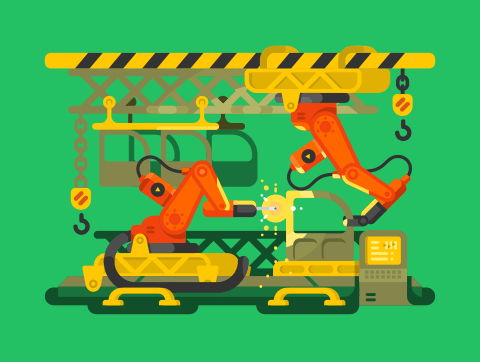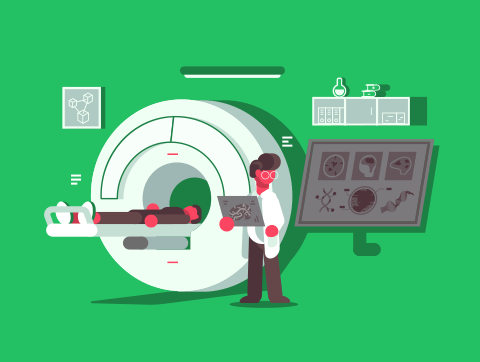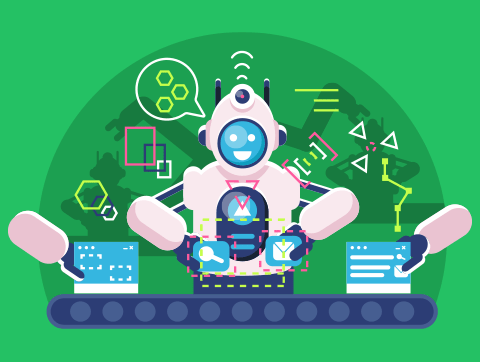Introduction
As we saw in the previous lesson, digital devices are used in all aspects of life and in all different workplaces.
No matter where you work, digital devices are always an integral part of the business.
In this lesson, we’ll learn about:
- Manufacturing uses
- Healthcare uses
- Creative task uses
- Automation & robotics uses

Manufacturing Uses
Digital devices play a critical role in manufacturing processes.
These devices have transformed how products are designed, assembled, and maintained.
Some examples of how digital devices are used for manufacturing include:
- Computer-Aided Design (CAD) and Computer-Aided Manufacturing (CAM)
- 3D Printing in Manufacturing
- Quality Control and Monitoring
Let’s look at each of these uses in more detail.

Manufacturing Uses
CAD & CAM
One significant way digital devices are used in manufacturing is through CAD and CAM systems.
CAD software allows designers to create detailed digital models of products before they are physically made. These models are more accurate and easier to modify than traditional drawings.
CAM systems take these digital designs and use them to control machinery on the factory floor.
For example, a CAM system might control a CNC (Computer Numerical Control) machine to cut metal parts with precision. This ensures the manufacturing process is consistent and efficient, reducing waste and costs.

Manufacturing Uses
3D Printing in Manufacturing
3D printing is a revolutionary way digital devices are used in manufacturing. Using a digital model created with CAD software, a 3D printer builds a physical object layer by layer.
This technology is used to create prototypes quickly and cost-effectively. For example, car manufacturers can produce prototype parts to test designs before moving to mass production.
It also enables manufacturers to produce custom or complex parts that would be difficult or expensive to make with traditional methods.
3D printing reduces waste, as it only uses the material necessary to build the object. It also allows for rapid adjustments to designs, improving the efficiency of the manufacturing process.

Manufacturing Uses
Quality Control and Monitoring
Digital devices are essential for quality control in manufacturing.
Sensors and cameras connected to computers can inspect products on the production line. These systems can detect defects that might not be visible to the human eye.
For example, a camera system might check the dimensions of a part to make sure it matches the specifications. If the part doesn’t meet the standard, the system can alert a worker or automatically remove the faulty item from the line.
Digital devices can also monitor machinery to ensure it is working correctly. This is known as predictive maintenance.
Sensors can detect when a machine might be about to fail, allowing repairs to be made before a breakdown occurs. This reduces downtime and keeps the factory running smoothly.

Quick Quiz: Manufacturing Uses
Healthcare Uses
Digital devices have transformed healthcare, improving the way we diagnose, treat, and manage medical conditions.
Some examples of how digital devices are used for healthcare include:
- Digital Imaging and Scanning
- Electronic Health Records (EHRs)
- Wearable Health Devices
Let’s look at each of these uses in more detail.

Healthcare Uses
Digital Imaging and Scanning
Digital devices are essential for modern medical imaging.
Equipment such as X-ray machines, MRI scanners, and ultrasound devices produce detailed images of the inside of a patient’s body.
These digital images help doctors diagnose conditions more accurately. For example, an MRI scanner can detect brain tumors or spinal injuries that would be difficult to diagnose through physical examination alone.
Digital imaging also allows images to be shared easily with specialists in other locations, enabling faster and more collaborative diagnoses.

Healthcare Uses
Electronic Health Records (EHRs)
Hospitals and clinics use digital devices to maintain Electronic Health Records.
These records contain all of a patient’s medical history, including test results, prescriptions, and treatment plans.
EHRs make it easier for healthcare providers to access a patient’s information quickly and securely.
This improves the efficiency of care, reduces errors, and ensures that doctors have the information they need to make informed decisions.
Patients can also access their own records online, which helps them stay informed about their health.

Healthcare Uses
Wearable Health Devices
Wearable health devices, such as smartwatches and fitness trackers, are becoming increasingly popular.
These devices monitor vital signs like heart rate, blood pressure, and oxygen levels in real-time.
For example, a smartwatch might alert a user if their heart rate becomes irregular, prompting them to seek medical advice.
Some wearables can even detect conditions such as sleep apnea or atrial fibrillation.
In hospitals, wearable devices can monitor patients continuously, reducing the need for manual checks by nurses.

Quick Quiz: Healthcare Uses
Creative Task Uses
The creative industry has benefited a lot from the growth of digital devices.
Digital devices are now used to perform most tasks within these industries, almost entirely replacing the older tools once used.
Some examples of how digital devices are used for creative tasks include:
- 3D graphics
- Photo & video editing
- Graphic design
Let’s look at each of these uses in more detail.

Creative Task Uses
3D Graphics
The video game and film industry makes heavy use of personal computers for the creation of 3D graphics.
In the film industry, ‘CG effects’ have heavily replaced older-fashioned physical effects.
In almost every movie released nowadays, you see 3D models produced using digital devices.
This is because it is often quicker and more flexible, as changes can be easily made to a 3D model.
Similarly, most high-end video games use 3D graphics for the game characters and environments.
This has added a new level of realism to video games, and we’re even using Virtual Reality headsets to experience the graphics in 3 dimensions.

Creative Task Uses
Photo & Video Editing
One of the biggest benefits of taking photos and videos using digital cameras is that we can load them onto a PC for editing.
Professional photographers now heavily use both digital cameras and personal computers for this purpose.
This might be fixing the lighting of a picture of a house that an estate agent is selling or removing certain objects from the image.
It could also be removing blemishes, such as spots or red-eye, from a photo of a person.
In addition, the movie industry relies on digital cameras and PCs for filming and editing, enhancing efficiency and flexibility.
Video editing software allows for quick edits, simpler corrections, and easy duplication for backup.

Creative Task Uses
Graphic Design
Personal computers with graphics editing and desktop publishing software are used to create logos, leaflets, brochures, magazines, books, and comics.
Once, graphic designers mainly worked by hand, including manually typesetting books by positioning individual characters on a printing press.
However, we now use desktop publishing software to design layouts and typesetting for books & magazines.
This is much more efficient than manually typesetting a book, which would involve the painstaking positioning of the individual characters.
We can also quickly send the data to printers, such as by email, to produce the final book, magazine, etc.

Quick Quiz: Creative Task Uses
Automation & Robotics Uses
Automation and robotics are transforming industries by taking over tasks traditionally done by humans.
Some examples of how digital devices are used for automation & robotics include:
- Industrial robots
- Smart home automation
- Autonomous vehicles
Let’s look at each of these uses in more detail.

Automation & Robotics Uses
Industrial Robots
Industrial robots are used in factories to perform repetitive and complex tasks.
These robots are controlled by digital devices and can work more quickly and accurately than human workers.
For example, robots in car factories assemble parts, weld components, and paint vehicles.
They can work continuously without breaks, which increases productivity.
Robots can also handle hazardous tasks, reducing the risk of injury to human workers.

Automation & Robotics Uses
Smart Home Automation
Digital devices have made home automation more accessible.
Smart home systems allow users to control appliances, lighting, heating, and security systems through mobile apps or voice commands.
For example, a smart thermostat can learn your routine and adjust the temperature to save energy.
Smart security systems can detect intruders and send alerts to your phone, ensuring your home is always protected.

Automation & Robotics Uses
Autonomous Vehicles
Autonomous vehicles, such as self-driving cars, use digital devices to navigate roads and avoid obstacles.
These vehicles rely on sensors, cameras, and AI to make real-time decisions.
For example, delivery robots and drones are becoming more common in industries like retail and logistics.
They can deliver goods without human intervention, reducing delivery times and costs.

Quick Quiz: Automation & Robotics Uses
Lesson Summary
Manufacturing uses of digital devices include CAD and CAM, 3D printing, and quality control and monitoring.
Healthcare uses of digital devices include digital imaging and scanning, Electronic Health Records (EHRs), and wearable health devices.
Creative Task uses of digital devices include 3d graphics, photo & video editing and graphic design.
Automation & Robotics uses of digital devices include industrial robots, smart home automation, and autonomous vehicles.
